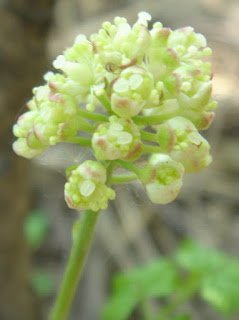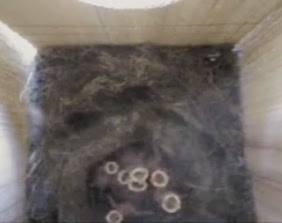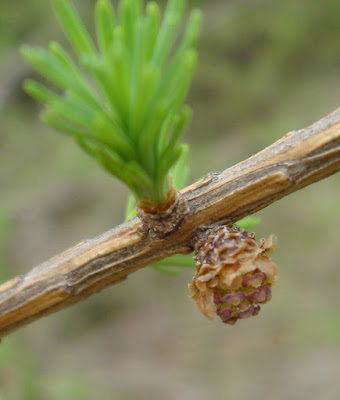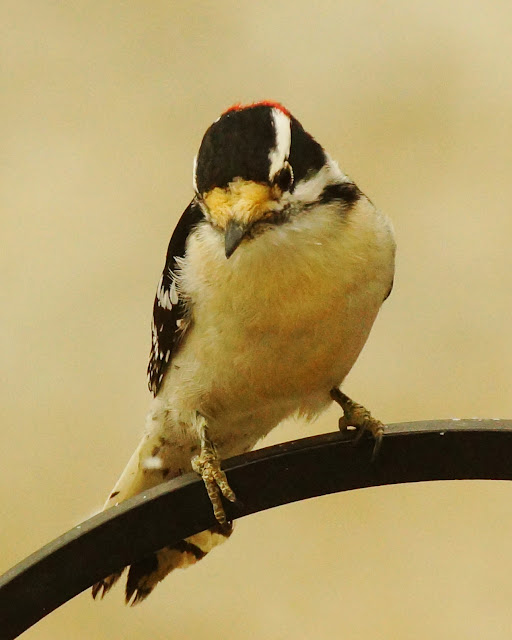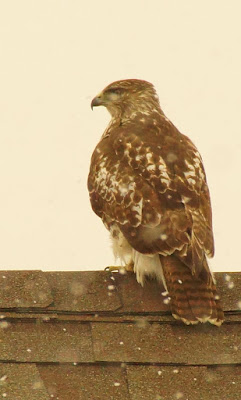Tree Swallows Tachycineta bicolor, who line their nests with found feathers, fledged their five young out of the nestbox a few days ago. This is what I found when clearing out the box. I clean and save such feathers, then put them out again in Springtime for the next nesting season. Some birds place colored or shiny items in their nest . . . wire, yarn, ribbons, etc.
This collection included a little blue sparkly hair pin!
7/02/2016
6/28/2016
baneberry
Red Baneberry, also known as Toadroot and
Chinaberry, grows in shady damp areas.
The white flowers grow in spikes that bloom during May in the wild wild
woods. Through the summer months,
Baneberry Actaea rubra ripens its fruits, which are egg-shaped berries, one-half inch long,
shiny, containing several seeds. In late summer, the berries turn bright red
with a black dot on them. The berries
are bitter and very poisonous, except to birds that disperse the seeds.
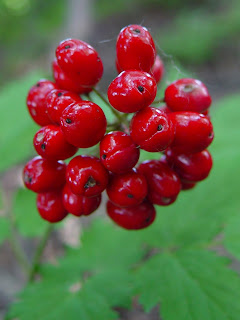
6/11/2016
Downy woodpeckers and squirrel
When the adult birds are away, a red squirrel comes by to see if he can peek in.
6/04/2016
Downy Woodpeckers feeding young
6/03/2016
Worms? Monsters?
Worms? Monsters? These are “finger galls”.
Insects or mites feeding on a leaf, or laying eggs on or injecting eggs into part
of a plant, cause galls to form. The leaf tissue reacts by increased production of normal plant
hormones and localized plant growth.
The outcome is an abnormal plant structure called a gall. These look like tiny wiggly "fingers" protruding from elm leaves.
Gall formation usually occurs in late spring during the
accelerated growth period of new leaves, shoots, and flowers. This is when insects might be feeding on plant tissue, or emerging in their life cycle to lay eggs. The gall-making insect develops inside the gall and the
gall continues to grow as the organism feeds and matures. In autumn and winter, some birds feast on
the insects they find inside galls, especially on goldenrod.
5/23/2016
peek inside a nest
A pair of Tree Swallows Tachycineta bicolor are nesting in one of several nest boxes near the wild wild woods. Today she laid the third egg. She is not yet incubating them, but keeps guard at the box opening all day.
5/22/2016
feeding baby birds
5/21/2016
furnishing a nestbox: House Wren
A House Wren Troglodytes aedon carries twigs, one at a time, to a nest box.
The male works until he fills the box with twigs, leaving a small cup or cavity.
The female adds soft grasses, fur, feathers, and junk to line the cup where she will lay her eggs.
Below, we peek inside another nest box containing a cozy nest for seven wren eggs.
The female will incubate the eggs for about 2 weeks.
5/20/2016
woods in bloom
top left: Arisaema triphyllum Jack-in-the-Pulpit; top middle: Geranium maculatum Wild Geranium; top right: Asarum canadense Wild Ginger; and a view of Aquilegia Columbine, all blooming now in the wild wild woods.
5/15/2016
nest cavity
A pair of Downy Woodpeckers decided the tree stump near the feeder garden is a good prospect for their 2016 nest cavity. They've been excavating into the old tree for a few weeks. Today, the female peeked out long enough for a look around; it was long enough for us to get a look at her!
5/14/2016
new hatchlings
Seven little Black-capped Chickadee eggs hatched in the last few days. The nestbox cam caught a snapshot when they were all gaping for food.
5/09/2016
4/30/2016
NestWatch
NestWatch, the citizen science project!
We look for cavity-nesting birds in trees as well as in nest boxes. A pair of Downy Woodpeckers has been excavating this hole overlooking the feeder gardens. Both will work at the nesting hole for up to three weeks. Their intent is to make a cozy cavity up to a foot deep in which to lay their eggs. They will line the bottom with woods chips. "Downies" usually lay 3 to 8 eggs; the eggs are white so the parents can see them in their dark cavity.
NestWatch

NestWatch!
Several nest boxes are in the yard and woods, waiting for cavity-nesting birds. Each box has a small video cam so we can watch the nest without disturbing the birds.
In this box a thick layer of moss was installed; then we saw grasses being laid in, re-arranged daily. The chickadee evidently laid her eggs over the past week, burying each one deep under the grass away from predators. Today, she started incubating them by gathering all seven and sitting close on them. A short flight outside revealed this treasure.
4/28/2016
4/19/2016
deciduous conifers
These new cones and needle-like leaves are emerging on our non-native European Larch Larix decidua. The old cones (at top in the photo) commonly remain on the tree for many years, turning dull grey-black. From a distance, the new cones look like rosey flowers on the Larch tree.
native deciduous conifers
Needle-like leaves (right) emerging in clusters, and new cones developing on the deciduous conifer American Larch Larix laricina. The seed cones will become 3/4" long, bright rosey red, and mature to lustrous brown scales containing the seeds.
The needle-leaves grow in dense clusters spirally on branches. They will glow bright green all summer, then turn golden before dropping in winter.
4/17/2016
viburnum
A very few of last year's berries remain on the American cranberry bush as colorful background for the new buds of this year's leaves. This Viburnum trilobum 'Hahs' produces high-pectin berries that hold well into winter and provide nourishing food for birds during cold months when insects are scarce.
4/15/2016
bloodroot
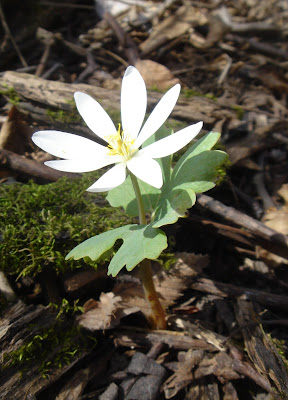 Bloodroot. Thick juicy underground stems. Sap of blood red. Sanguinaria, its fitting Latin name, meaning blood red. But walking in the woods, you'll see innocent white flowers on pinkish stalks with a bright attractive center. The stem, leaf, and flower bud (in a neat wrapped bundle) are pushed up together through early Spring leaf litter. The delicate flower only lasts a day or two. Bees pollinate bloodroot. Once blossoming, it develops pod-like capsules that contain seeds. Ants harvest and spread the mature seeds.
Bloodroot. Thick juicy underground stems. Sap of blood red. Sanguinaria, its fitting Latin name, meaning blood red. But walking in the woods, you'll see innocent white flowers on pinkish stalks with a bright attractive center. The stem, leaf, and flower bud (in a neat wrapped bundle) are pushed up together through early Spring leaf litter. The delicate flower only lasts a day or two. Bees pollinate bloodroot. Once blossoming, it develops pod-like capsules that contain seeds. Ants harvest and spread the mature seeds.3/29/2016
alarm calls in the woods
The raptor Coopers Hawk came to the water bowl for a drink, then dropped his tail feathers into the cold water while looking around for dinner.
All the songbirds freeze in place and get very quiet when a raptor appears. They don't want to be seen or heard, for fear of becoming a raptor's meal.
Read a fascinating article about alarm calls that birds make to alert others of a raptor hunting in the area . . .
https://www.allaboutbirds.org/look-out-the-backyard-bird-alarm-call-network/
3/23/2016
3/04/2016
feathers of Downy Woodpeckers
Downy woody Picoides pubescens
is the smallest woodpecker of the wild wild woods. We see two or three at a time, searching up and down the trees for insects within the folds of bark.
The nasal bristles (stiff yellow feathers above the beak) keep wood crumbs out of the bird's nasal openings as he searches for food or excavates a nest hole in a tree.
Downy Woodpeckers stop at the water bowl too, where this tiny feather was left behind. It may be from the top of this male's head.
a murder of crows
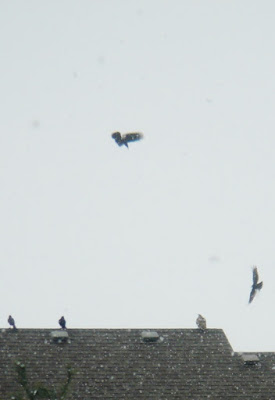
This hawk was gliding over the feeder garden looking for breakfast. The American Crows, who had been snatching peanuts from the tray feeder, gave chase. The hawk landed on a nearby roof. The crows dive-bombed in an effort to scare the hawk away. The hawk calmly waited, squawked a few times, then lifted off towards the river for a better chance at hunting.
3/03/2016
feet and beak
We heard the shrill whinnying calls of the male Pileated Woodpecker Dryocopus pileatus as he made his way through the woods, then came to the suet block for breakfast. He thrust his strong beak into the food, scattering some crumbs to the ground and gulping a few pieces into his gullet. Once he had a mouthful, he went to a nearby tree where he used the rough bark to hold the suet as he consumed it. His tongue has a spear-like tip bearing backward-facing barbs that allow him to lick food items from between the folds of tree bark. Pileated Woodpeckers' favorite food is carpenter ants; also other ants, wood boring beetle larvae, termites, flies, caterpillars, cockroaches, grasshoppers, wild fruits and nuts.
Woodpeckers have zygodactyl feet (two toes facing forward, one facing back) and allows these birds to easily climb and grasp bark, tree branches and other structures.
Subscribe to:
Posts (Atom)

